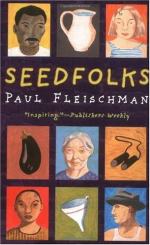|
This section contains 329 words (approx. 1 page at 400 words per page) |

|
Seedfolks Summary & Study Guide Description
Seedfolks Summary & Study Guide includes comprehensive information and analysis to help you understand the book. This study guide contains the following sections:
This detailed literature summary also contains Quotes and a Free Quiz on Seedfolks by Paul Fleischman.
The following version of the novel was used to create this study guide: Fleischman, Paul. Seedfolks. HarperTeen, July 30, 2013. Kindle.
In his novel, Seedfolks, author Paul Fleischman follows the development of a community garden through the voices of the diverse people who contribute to the project. These voices range from Kim, a young girl who started the garden by planting lima beans in a vacant lot in the hope that her father would see her and recognize her as his daughter, to Leona, the young black mother who campaigned to get the city of Cleveland to remove the trash from the vacant lot. Through its first year, the garden gave the residents of the neighborhood a reason to take pride in the place they lived and brought them together as a community.
Amir, a man from India tells the reader in his section of the novel: “Cleveland is a city of immigrants” (60). Fleischman demonstrates this diversity through the 13 different people he chooses to tell the story, including Vietnamese, Haitians, Indians, English, blacks, and whites. Before the garden, the vacant lot was filled with filled with trash. The neighborhood was crime-ridden and people tended to keep to themselves, not even bothering to get to know their neighbors. When Kim planted her seeds in the lot, Ana assumed that Kim was involved in some wrongdoing, an example of the mindset of the people who lived there.
Through the course of the first year, the people who gardened together began to take pride in their neighborhood. They tracked down and scolded people who threw trash on the lot. They shared what they knew about gardening and sometimes learned how little they actually knew about growing food. The gardeners began to feel a sense of community as they helped each other and looked out for each other. This novel demonstrates the therapeutic nature of gardening and the amazing way that something as simple as a garden can bring people together.
Read more from the Study Guide
|
This section contains 329 words (approx. 1 page at 400 words per page) |

|



